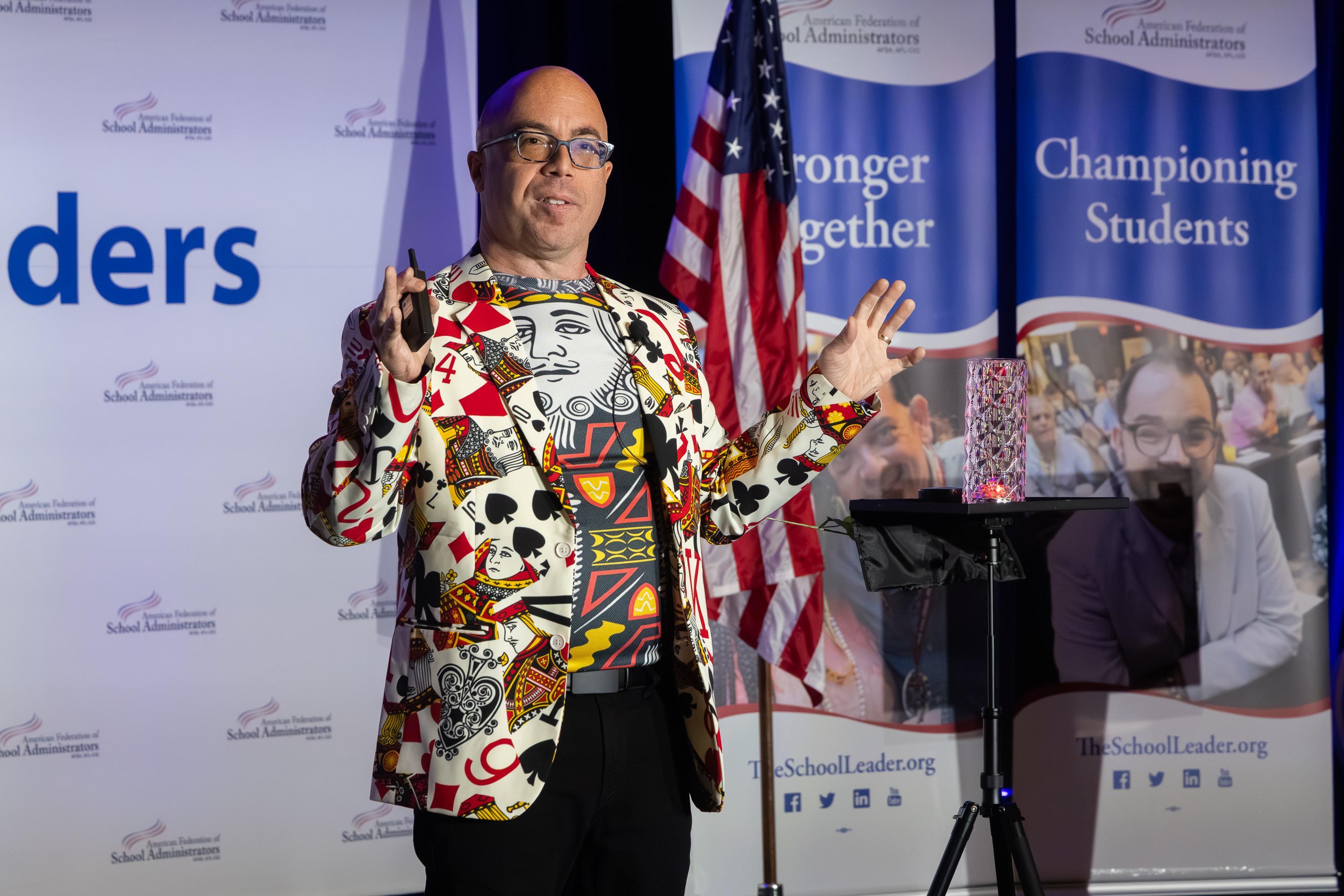Artificial intelligence (AI) can save time and spark creativity, but its true promise will be realized only when paired with human-centered skills, Staten Island Technical High School Principal Mark Erlenwein told school leaders during a keynote address at AFSA's 17th Triennial Convention.
According to Erlenwein, AI is rapidly transforming how school leaders manage daily operations, communicate with families and design student learning experiences. He worked to “demystify” AI, strip away sensationalist fears and demonstrate how the technology can serve as a time-saving, creativity-boosting assistant that still depends on human judgment.
“This is not an app fest,” Erlenwein told a room of principals, assistant principals, district administrators, retirees and union leaders. “My goal is to help you transform the way you lead your schools.” He invited the audience to think of AI as a tool that can handle routine, time-consuming tasks so school leaders can focus on the human work that machines cannot replace.
Erlenwein opened with practical demonstrations showing how AI can be embedded into an administrator’s daily routine. During his short commute, he often asks ChatGPT to draft complex items before he even reaches his desk: a nine-period bell schedule with built-in passing times, curated two- to five-minute motivational video recommendations for a faculty meeting and polished drafts of articles produced from uploaded video recordings.
In one real-world example, he uploaded a lengthy student interview and asked AI to pull out quotes, then had it draft an article in his own voice. “The funny thing was, when the local paper later ran a story, they picked the same quotes AI had flagged,” he said.
When an urgent PTA payment request landed at 5 p.m. on a Friday—right before his anniversary dinner—Erlenwein turned to AI. “Normally that would have taken me 30 minutes of agonizing to get the tone right. Instead, by 5:05 I was out the door, and my wife was happy,” he joked, drawing laughs and applause from the audience.
He showed how AI can generate draft teacher observation reports using frameworks like Danielson, combining low-inference observation notes, lesson plans and teacher preferences about feedback. “One teacher told me: ‘Please keep it short and sweet.’ Another wanted detailed bullet points. AI lets me give both exactly what they need—but remember, it’s a draft. My judgment still matters most.”
He also explained how image and synthetic media tools can be used positively. Using MyoStudio, he created professional headshots of his staff without paying for studio sessions. For a retiring teacher, he took a grainy old snapshot and had AI carefully restore and colorize it for a school naming ceremony. “When her family saw it, they cried. That’s the power of using this technology with heart,” Erlenwein said, prompting a ripple of applause.
Perhaps his most moving story involved multilingual communication. By training an AI avatar to speak in multiple languages, he was able to send personalized video messages to families who rarely engaged with the school. “We started hearing from parents who had never emailed us before. They said, ‘Thank you—finally someone is talking to me in my language,’” Erlenwein recalled. “That was the moment I knew this wasn’t about technology. It was about inclusion.” One attendee murmured, “That’s incredible—what a simple but powerful idea,” underscoring the audience’s engagement.
At Staten Island Tech, students built a neural network called SammyGPT to help families navigate the school website in multiple languages. At first it worked, but then it began “hallucinating” wrong answers. “It was embarrassing, sure,” Erlenwein said, “but the students learned more from fixing those mistakes than they ever could from reading a textbook.” A few audience members nodded knowingly, whispering, “We need to try that in our schools.”
Erlenwein’s keynote returned often to one theme: schools must double down on communication and human skills. He described how his “Talknology” initiative, paired with Voice 21’s oracy program, puts students into internships where they practice real-world communication. “We can’t let AI take away the struggle,” he warned. “Students still need to learn how to shake hands, look someone in the eye and make their voices heard.”
Balancing high tech with low tech was another theme. He described how a ham radio program helped students learn antenna building and emergency communication skills at virtually no cost. “In an emergency, when the internet goes down, that’s the tech you’ll want,” he told the audience. Several administrators called out, “That’s brilliant!”
He also described launching weather balloons carrying cameras and student-built sensors into near space. “When that payload comes back down, and kids see their experiment traveled 100,000 feet above Earth—trust me, no one is skipping class that day,” he said, earning chuckles and applause.
On the assessment front, Erlenwein championed his school’s restorative assessment center, where students can retake tests in a structured environment staffed by proctors. “We’ve stopped treating a single test on a single day as the be-all, end-all. Life doesn’t work like that—why should school?” he said.
He likened the shift to “moving the carrot to the middle of the stick”—motivating students with growth opportunities instead of one-shot penalties. A participant called out, “We need to bring that mindset to our district—immediately.”
Erlenwein encouraged administrators to embrace project-based learning and hands-on experiences. He highlighted his school’s maker space, used across disciplines from science to foreign languages, where students build, experiment and learn through process rather than memorization. One example included students attaching cameras, GPS units and sensors to helium balloons and sending them into near space to gather real scientific data. “Think big, think different,” he said. “These are the kinds of opportunities that students will never forget.”
Throughout the keynote, Erlenwein emphasized that AI should augment—not replace—human judgment. He shared examples of creating customized vocational training videos for students with diverse speech abilities, restoring old photos for heartwarming recognition ceremonies and using AI avatars to communicate in multiple languages. These efforts not only saved time but strengthened relationships with families and enhanced student learning.
“Don’t be afraid,” he concluded. “Use these tools to free up your time—then reinvest that time into the things that matter most: teaching kids how to communicate, how to collaborate and how to fail forward.” Applause filled the room, and one administrator said, “I’m leaving here inspired to rethink our entire approach to technology.”
Editors Note: AI helped in the development of this story.

